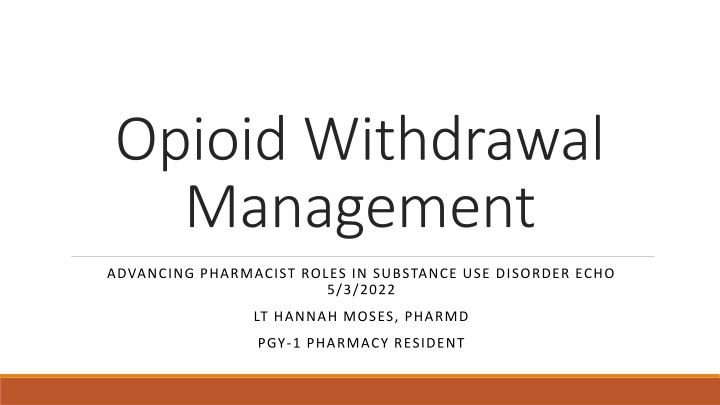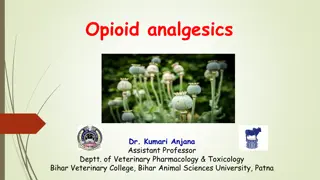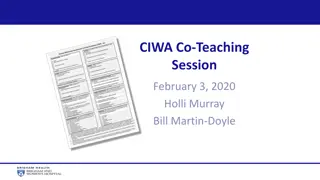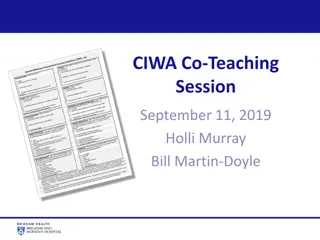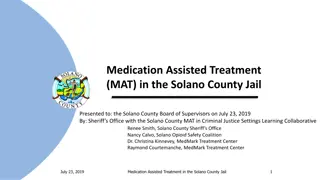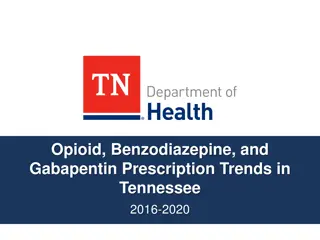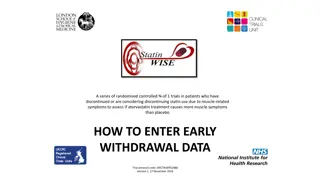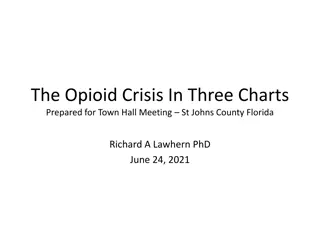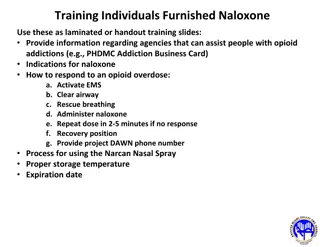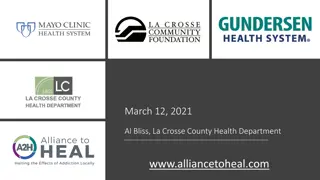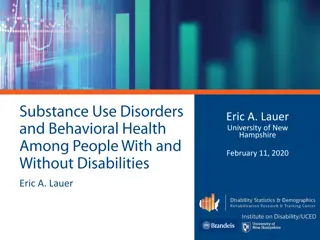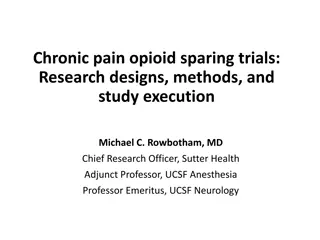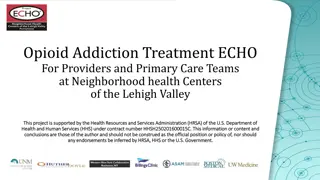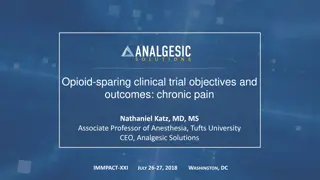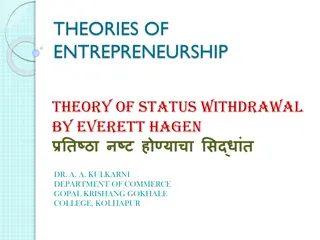Opioid Withdrawal Management
Explore opioid withdrawal management, identifying signs, symptoms, and treatment options. Understand the importance of safely transitioning patients to medication for opioid use disorder. Learn about opioid types, withdrawal syndromes, and situations warranting withdrawal management.
Download Presentation

Please find below an Image/Link to download the presentation.
The content on the website is provided AS IS for your information and personal use only. It may not be sold, licensed, or shared on other websites without obtaining consent from the author.If you encounter any issues during the download, it is possible that the publisher has removed the file from their server.
You are allowed to download the files provided on this website for personal or commercial use, subject to the condition that they are used lawfully. All files are the property of their respective owners.
The content on the website is provided AS IS for your information and personal use only. It may not be sold, licensed, or shared on other websites without obtaining consent from the author.
E N D
Presentation Transcript
Opioid Withdrawal Management ADVANCING PHARMACIST ROLES IN SUBSTANCE USE DISORDER ECHO 5/3/2022 LT HANNAH MOSES, PHARMD PGY-1 PHARMACY RESIDENT
No conflicts of interest No financial disclosures
1 2 3 Define opioid withdrawal management Identify signs and symptoms of opioid withdrawal Identify treatment options for withdrawal management Objectives
What Is Withdrawal Management (WM)? Treatment of withdrawal symptoms that are a result of stopping or reducing use of substances Common for people who complete WM to relapse to substance use 85% of individuals relapse within a year of treatment 2/3 s of individuals return to substance use within weeks of beginning treatment
Opioid Withdrawal What are opioids? Heroin, methadone, oxycodone, hydrocodone, morphine, codeine, fentanyl Uncomfortable and difficult Flu-like symptoms Rarely life-threatening Manage with caution in pregnancy
Safely and successfully transition patient to medication for opioid use disorder (OUD) Medical management is an important first step before psychosocial treatment begins Reduces discomfort Displays empathy Why Is WM Important?
Opioid Withdrawal Syndrome Short-acting opioids (heroin): Onset of withdrawal symptoms: 8-24 hours after last use Duration of symptoms: 4-10 days Long-acting opioids (methadone): Onset of withdrawal symptoms: 12-48 hours after last use Duration of symptoms: 10-20 days Fentanyl Highly lipophilic With regular use, can be sequestered in fat cells Can continue to be present in urine 7-14 days after last use
Situations That Warrant WM First step in treatment for opioid use disorder (OUD) Provider that was originally prescribing opioids for pain management is discontinuing treatment Post naloxone administration due to an overdose Patient prescribed maintenance methadone is being discharged from a treatment program OUD treatment with naltrexone
Withdrawal Symptoms and Adjunctive Medications Medically supervised opioid withdrawal during treatment for addiction - UpToDate
Receptor Involvement Once opioids have been stopped, neurotransmitter levels will decrease Dopamine Anxiety, Depression Serotonin Anxiety, Depression, Chronic pain GABA Chronic pain, Anxiety, Depression, Insomnia Acetylcholine Agitation, Insomnia, Restlessness
Recognizing Opioid Withdrawal Clinical Opiate Withdrawal Scale (COWS) No diagnostic test Urine drug screen (UDS) UDS is positive for most opioids for 48-96 hours after last use (besides fentanyl) Determine severity 11 common signs and symptoms Total scores: mild (5-12), moderate (13-24), moderately severe (25-36), and severe (>37) Score used to determine treatment options https://www.asam.org/docs/default-source/education-docs/cows_induction_flow_sheet.pdf?sfvrsn=b577fc2_2
Potential Risks of Withdrawal Neonatal Abstinence Syndrome (NAS) Increased risk of suicide Increased overdose risk
Treating Opioid Withdrawal Essential first step in OUD treatment Patients with severe chemical dependence often continue to use high doses of opioids to avoid withdrawal symptoms Treatment of withdrawal by itself rarely leads to long-term recovery FDA approved medications to treat opioid withdrawal Clonidine Buprenorphine Methadone
Clonidine MOA: Central inhibition of the hyper-noradrenergic state (alpha-2 adrenergic agonist) Should be used in adjunct to buprenorphine FDA labelled medication for opioid withdrawal management May be used as primary treatment when partial opioid agonist therapy is contraindicated or unavailable Relieve autonomic symptoms Sweating, diarrhea, intestinal cramps, nausea, anxiety, and irritability
Monitor blood pressure Should be used in caution with pre-existing heart condition or those who are on antihypertensive medications Can cause dizziness/syncope Dosing Medically supervised opioid withdrawal during treatment for addiction UpToDate The Centre for Addiction and Mental Health- 9cf2650a-37eb-41d0-afe5- e64cf1377c20 (495 238) (porticonetwork.ca) Clonidine Safety
Buprenorphine Partial mu-opioid agonist High binding affinity for mu-opioid receptor Alleviates withdrawal symptoms, reduces cravings, and can prevent relapse Slow dissociation long duration of action Can cause precipitative withdrawal symptoms Increased safety in overdose
Precipitative Withdrawal Symptoms Decrease in relative opioid effects caused by the introduction of a drug that reverses the effects of full agonist More severe than spontaneous withdrawal process Opioids still may be found in urine for days after last use Treatment should not be delayed if patient is experiencing mild- moderate withdrawal symptoms Withdrawal can be determined by history, examination, or standardized scale
Buprenorphine Dosing Clinic induction Home induction Micro-dosing strategy Maintenance screenings Ceiling effect Resources with dosing guides Medically supervised opioid withdrawal during treatment for addiction UpToDate Buprenorphine Quick Start Guide (samhsa.gov) The Centre for Addicition and Mental Health: Opioid withdrawal - Portico (porticonetwork.ca) A Patient s Guide to Starting Buprenorphine at Home: https://www.asam.org/docs/default- source/education-docs/unobserved-home-induction- patient-guide.pdf?sfvrsn=16224bc2_0 Substance Use Warmline- Clinician-to-Clinician Support https://nccc.ucsf.edu/clinician-consultation/substance-use- management/ (1-855-300-3595) available 6am to 5pm PST (Mon Fri)
Dangerous to dispense take-home doses to others Should be used in caution with alcohol, benzodiazepines, or other opioids Buprenorphine Safety Increased risk for opioid overdose if relapse occurs Naloxone distribution
Importance Of Buprenorphine Harm reduction April 2020-April 2021: CDC reported 100,306 drug overdose deaths 75,673 opioid overdose deaths Buprenorphine can be used as medication assisted therapy (MAT) to help decrease cravings for opioids Compared to patients not receiving MAT, death rates significantly decrease in patients receiving buprenorphine
Naltrexone Opioid antagonist Should not be used to treat opioid withdrawal Should only be administered if free from opioids for at least 7 to 10 days Must complete withdrawal to start medication Alternative Medications for OUD Treatment Methadone Full mu-opioid agonist Does not induce withdrawal symptoms when given if opioid agonist is present First dose should be given when patient enters mild to moderate withdrawal in order to gauge the efficacy of initial dose
Conclusion Medical and psychological care should both be provided to patients in order to reduce risk of relapse and prevent withdrawal symptoms Harm reduction is important to increase patient safety Individualized care Opioid withdrawal can be discomforting and should be treated with partial opioid agonists and symptomatic management medications
Everyday Resources Medically supervised opioid withdrawal during treatment for addiction UpToDate Buprenorphine Quick Start Guide (samhsa.gov) A Patient s Guide to Start Buprenorphone at Home: https://www.asam.org/docs/default-source/education- docs/unobserved-home-induction-patient- guide.pdf?sfvrsn=16224bc2_0 Opioid withdrawal - Portico (porticonetwork.ca) Substance Use Warmline- Clinician-to-Clinician Support https://nccc.ucsf.edu/clinician-consultation/substance-use-management/ (1-855-300-3595) available 6am to 5pm PST (Mon Fri)
References 1. Withdrawal Management - Clinical Guidelines for Withdrawal Management and Treatment of Drug Dependence in Closed Settings - NCBI Bookshelf (nih.gov) 2. Drug Addiction Recovery Statistics | Ashley Addiction Treatment (ashleytreatment.org) 3. Fentanyl and Norfentanyl Detected in Urine for 7 or More Days After Regular Use | Alcohol, Other Drugs, and Health: Current Evidence (bu.edu) 4. A Practical Guide to Urine Drug Monitoring - PMC (nih.gov) 5. Novel Buprenorphine Induction Strategies. James J. Gasper, PharmD, BCPP (UCSF) ECHO Presentation. Slide 1 (uclaisap.org) 6. Consensus Recommendations on the Treatment of Opioid Use Disorder in the Emergency Department ScienceDirect 7. Drug Overdose Deaths in the U.S. Top 100,000 Annually (cdc.gov) 8. Buprenorphine Therapy for Opioid Use Disorder - American Family Physician (aafp.org) 9. Opioid withdrawal symptoms, a consequence of chronic opioid use and opioid use disorder: Current understanding and approaches to management (wiley.com)
What barriers to withdrawal What barriers to withdrawal management or OUD management or OUD treatment have you seen treatment have you seen within your facility? within your facility?
What are the main access What are the main access points for opioid withdrawal points for opioid withdrawal presentation that have been presentation that have been observed in your facility? observed in your facility?
How can the pharmacist play a How can the pharmacist play a role in the treatment and role in the treatment and management of opioid management of opioid withdrawal that is within our withdrawal that is within our scope of practice? scope of practice?
